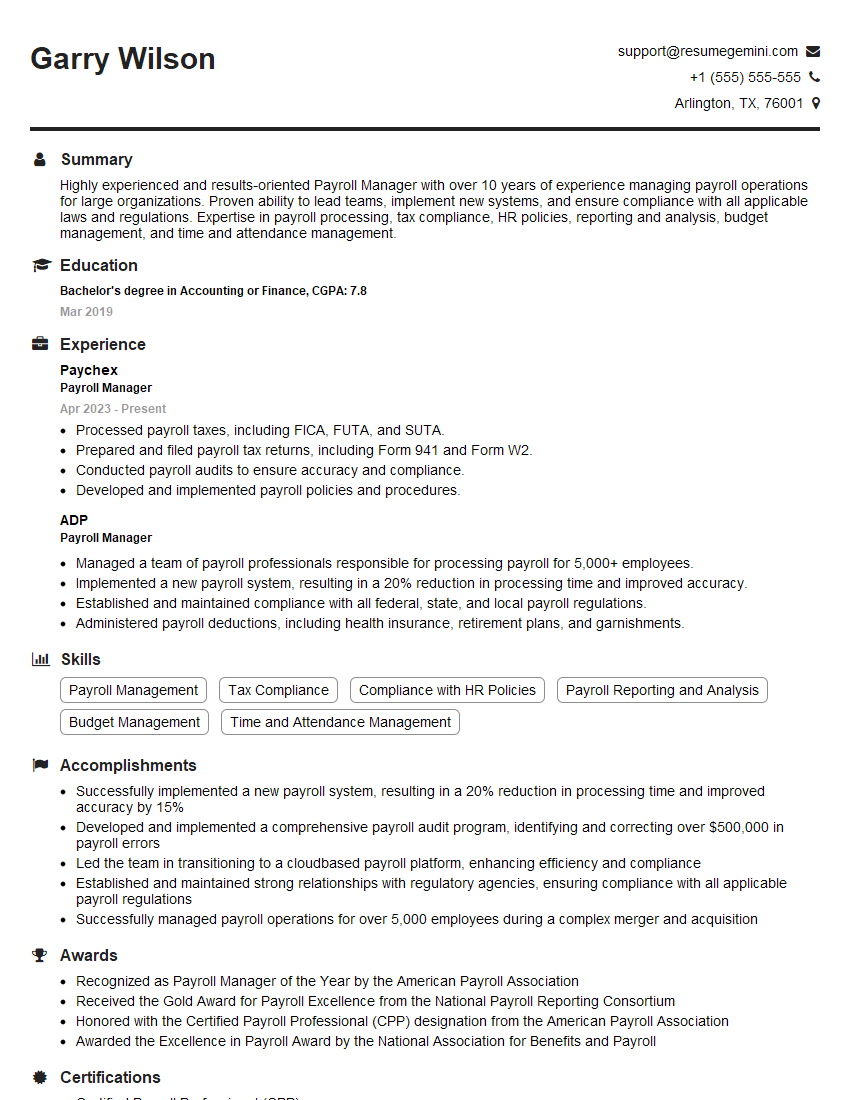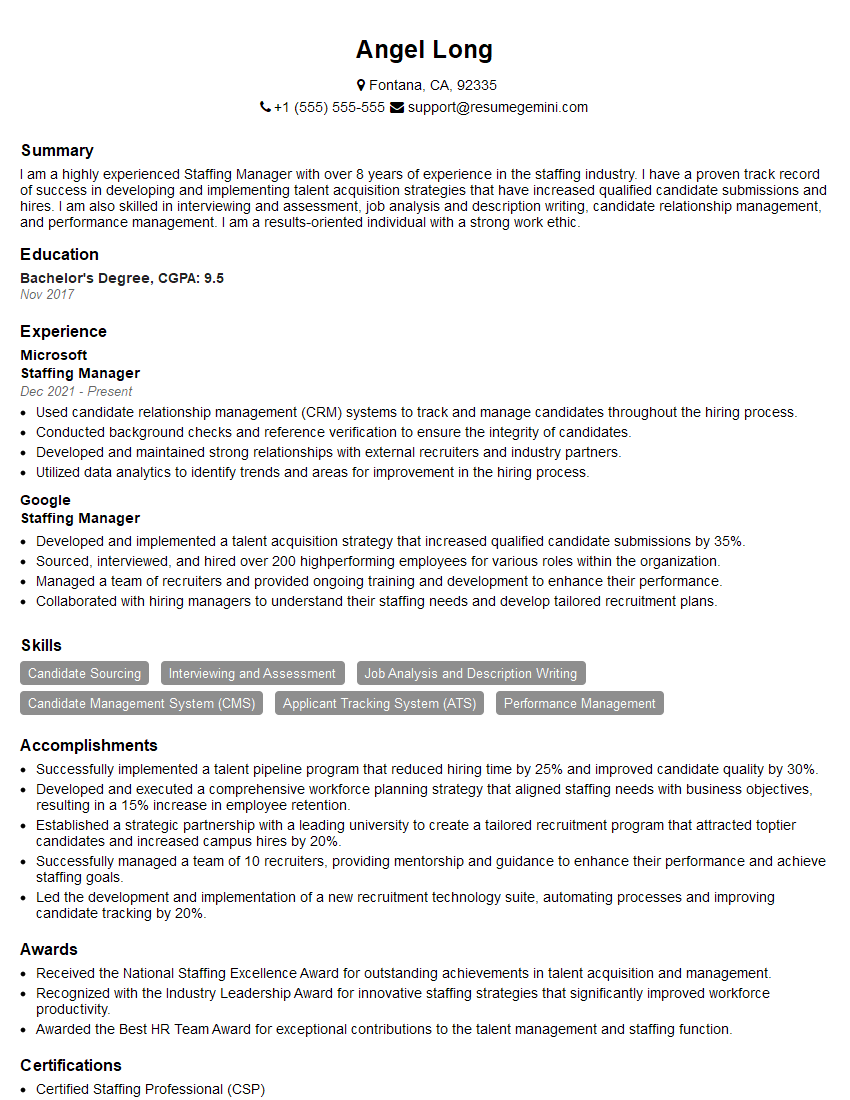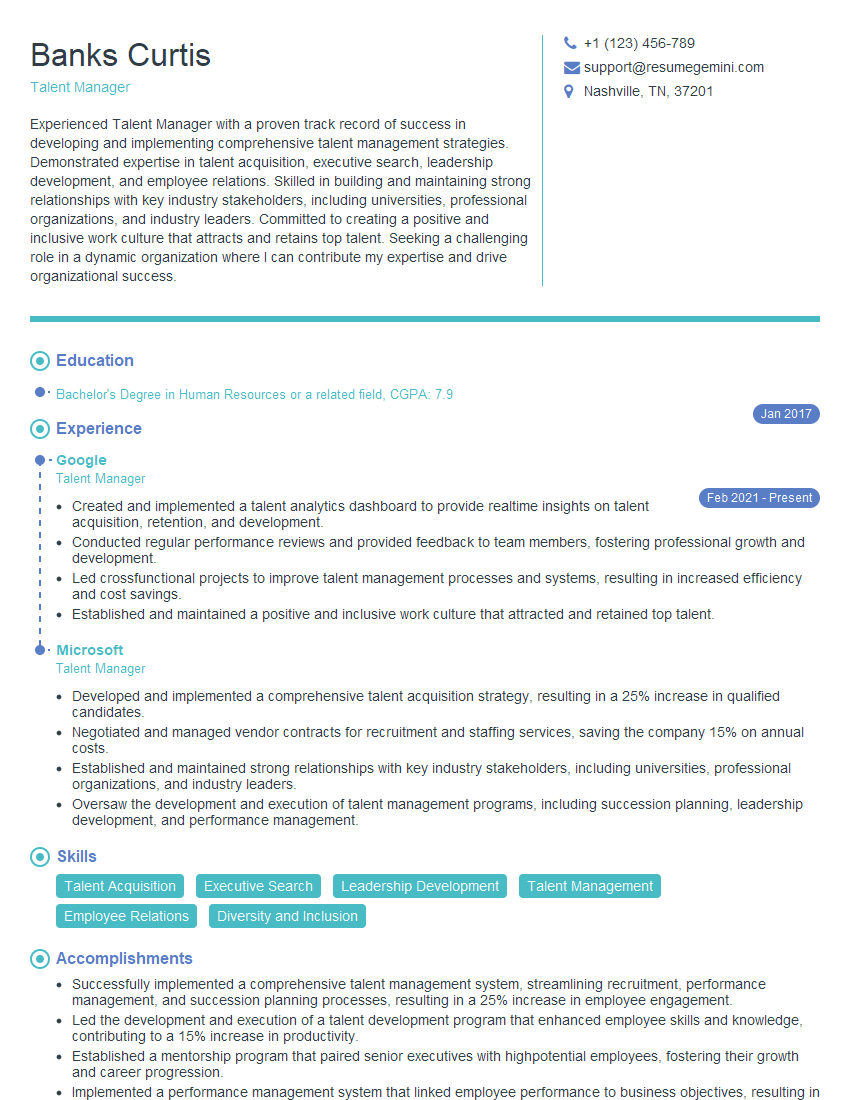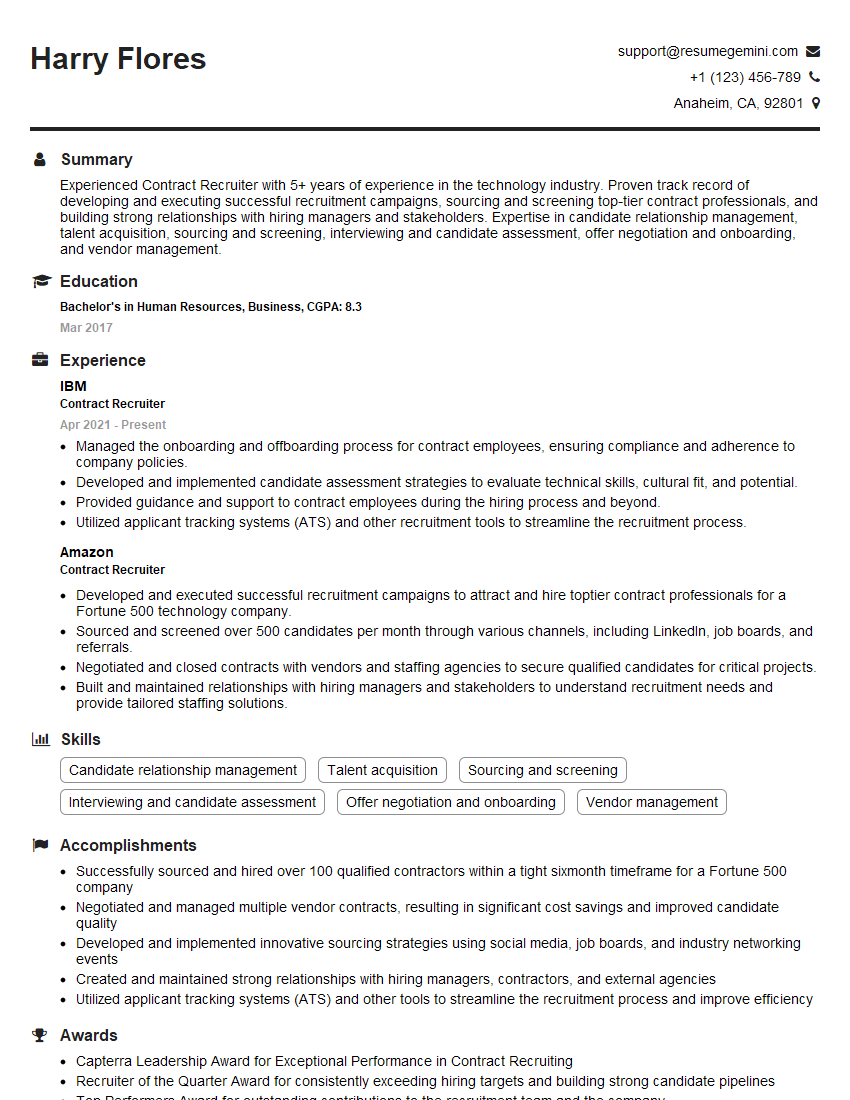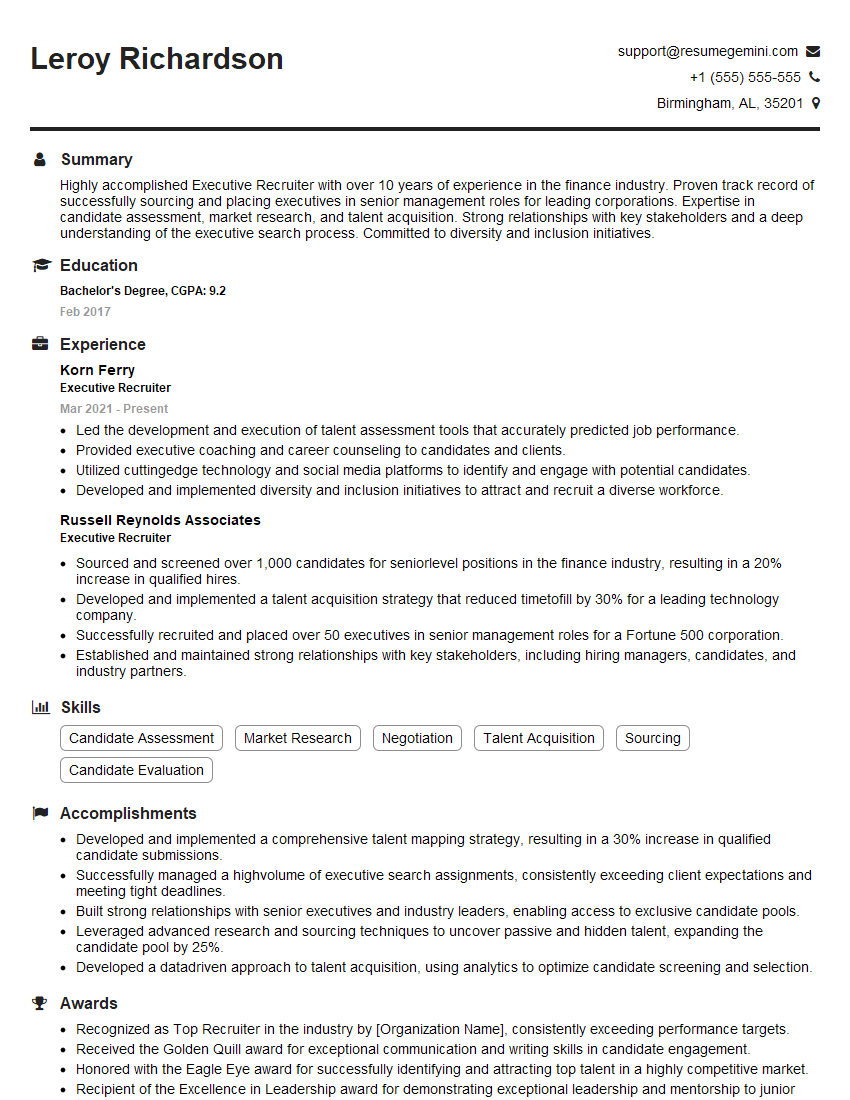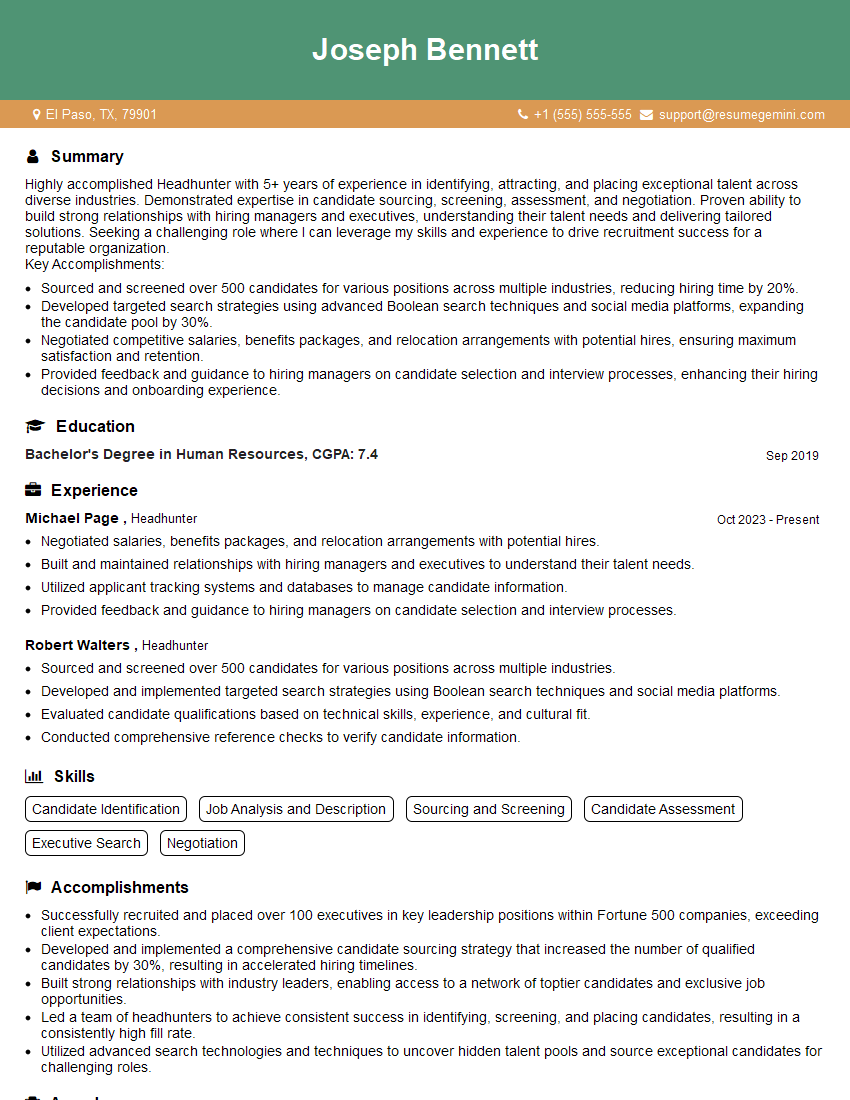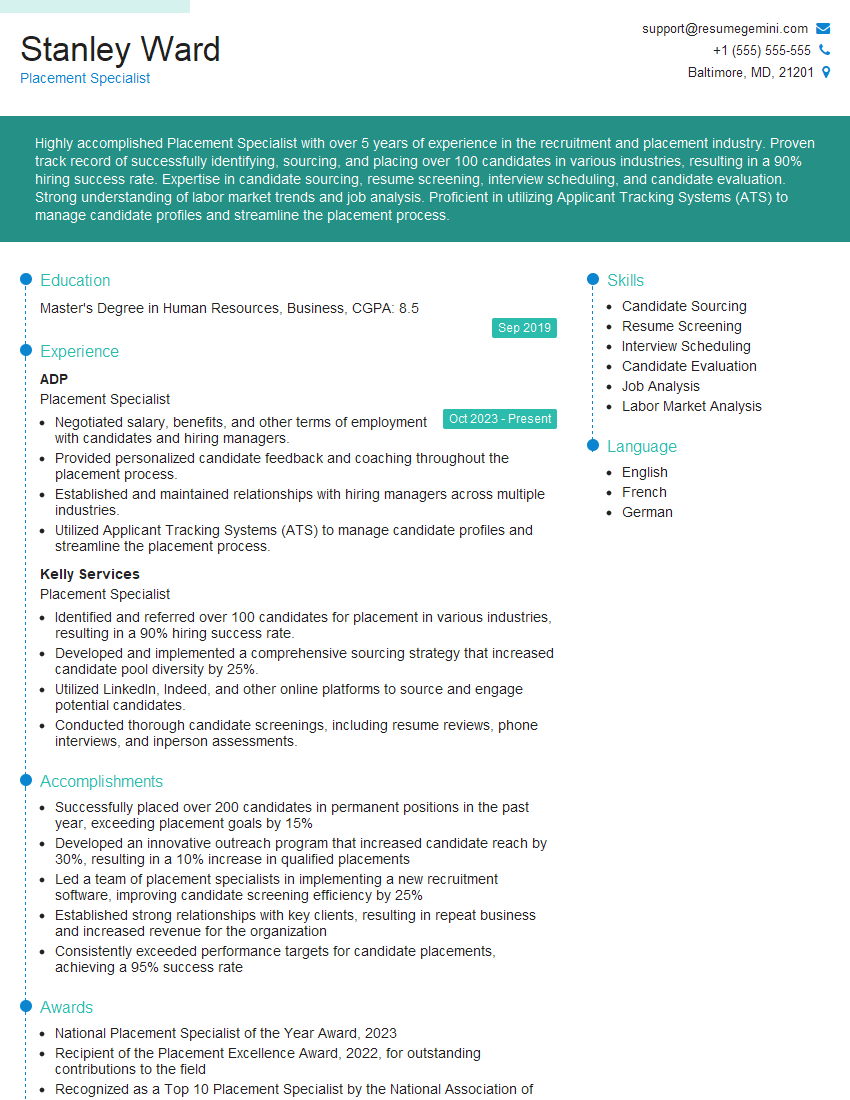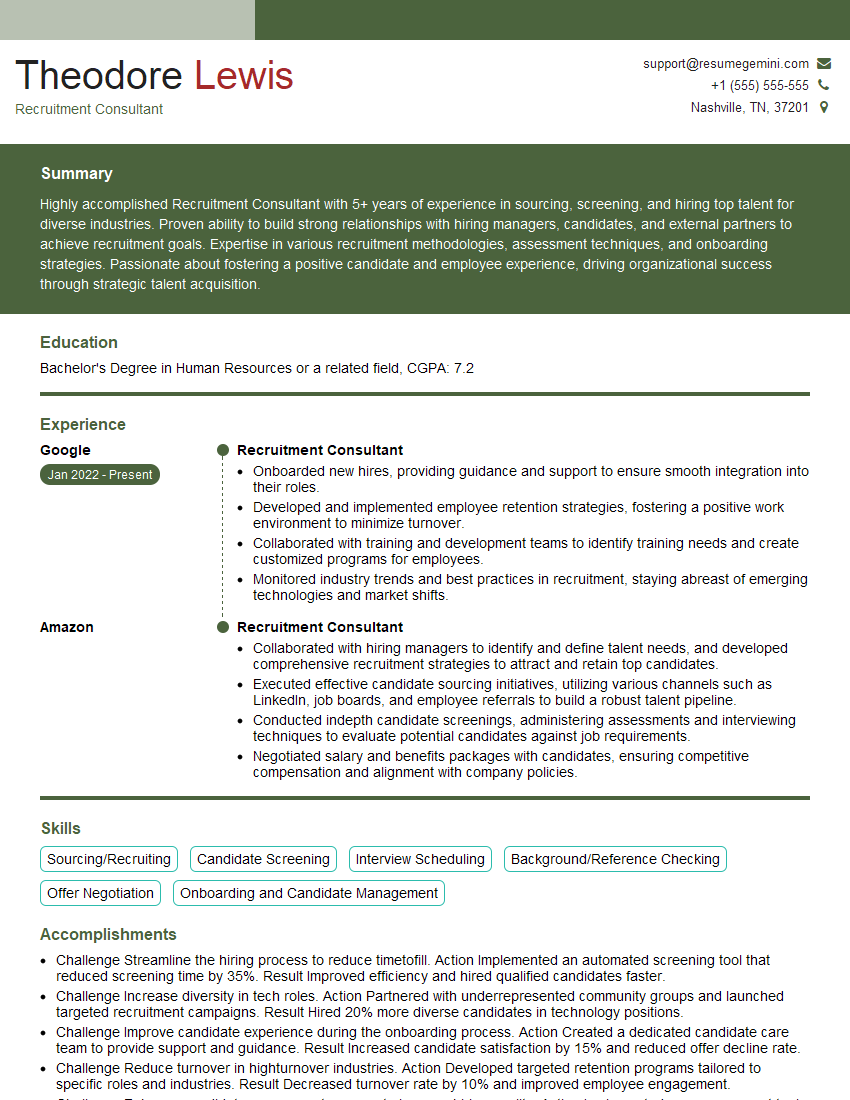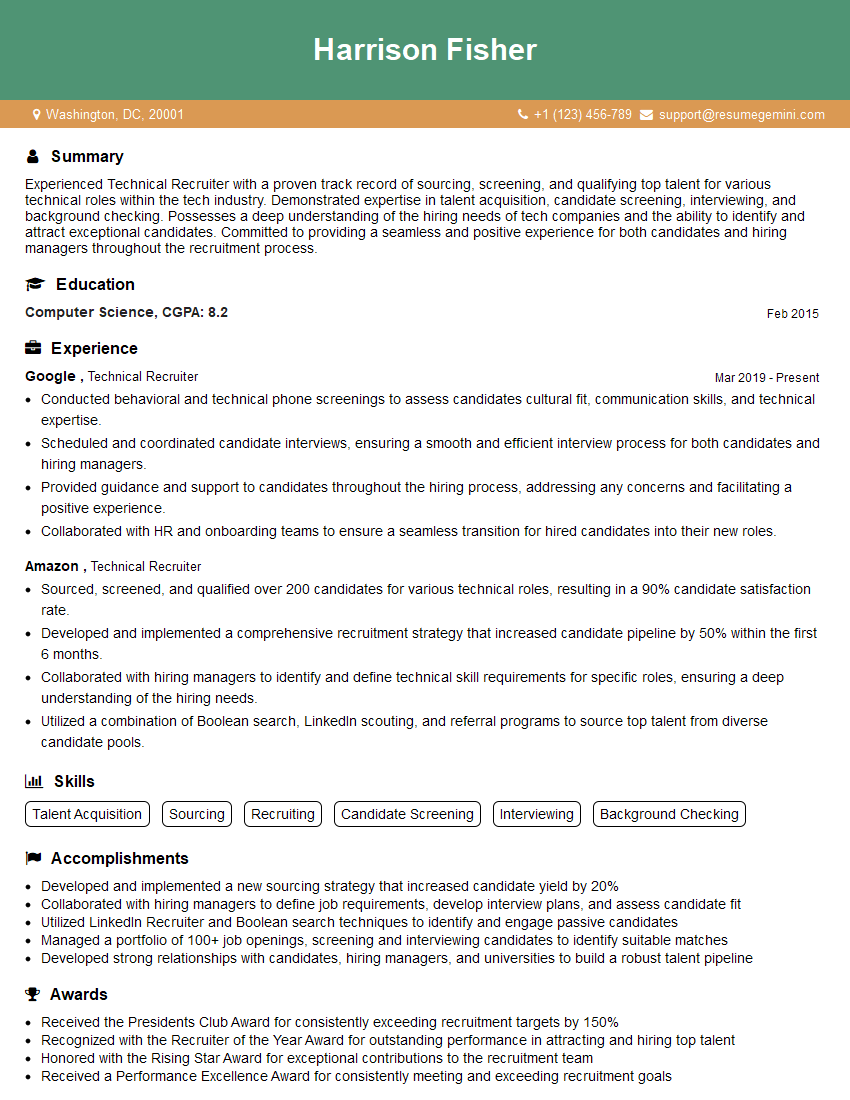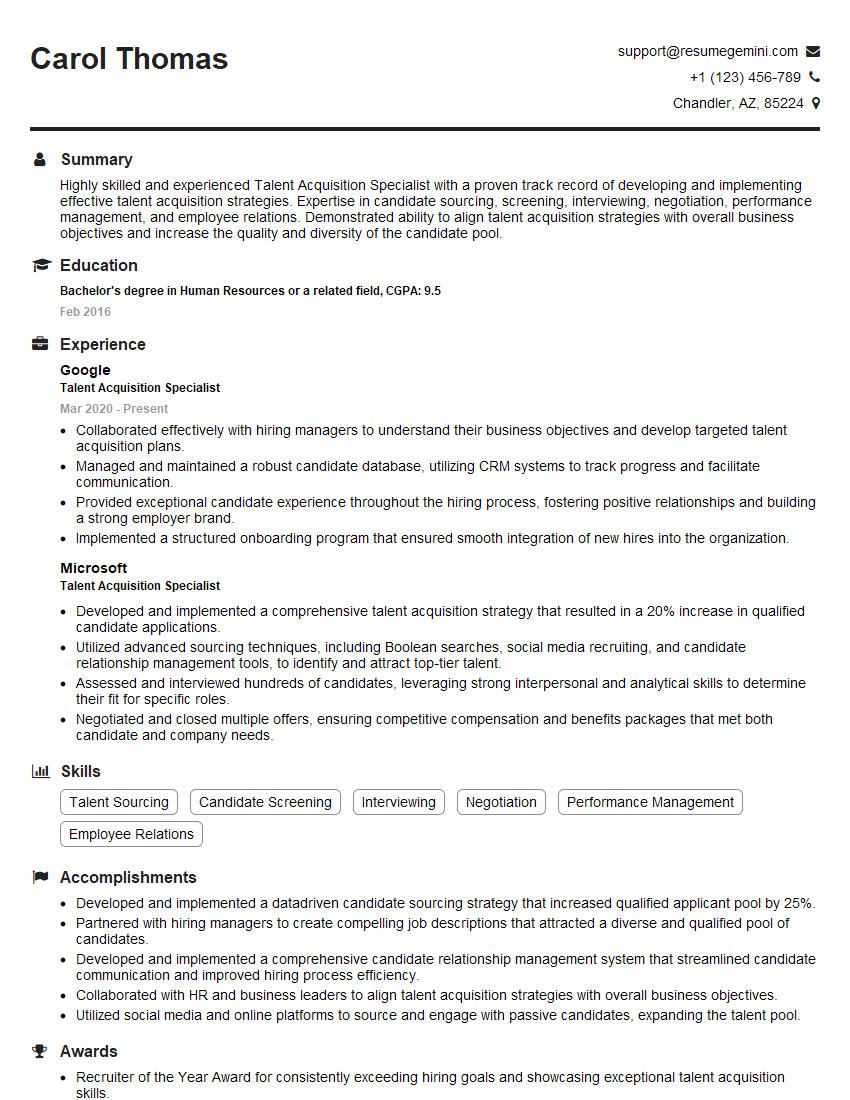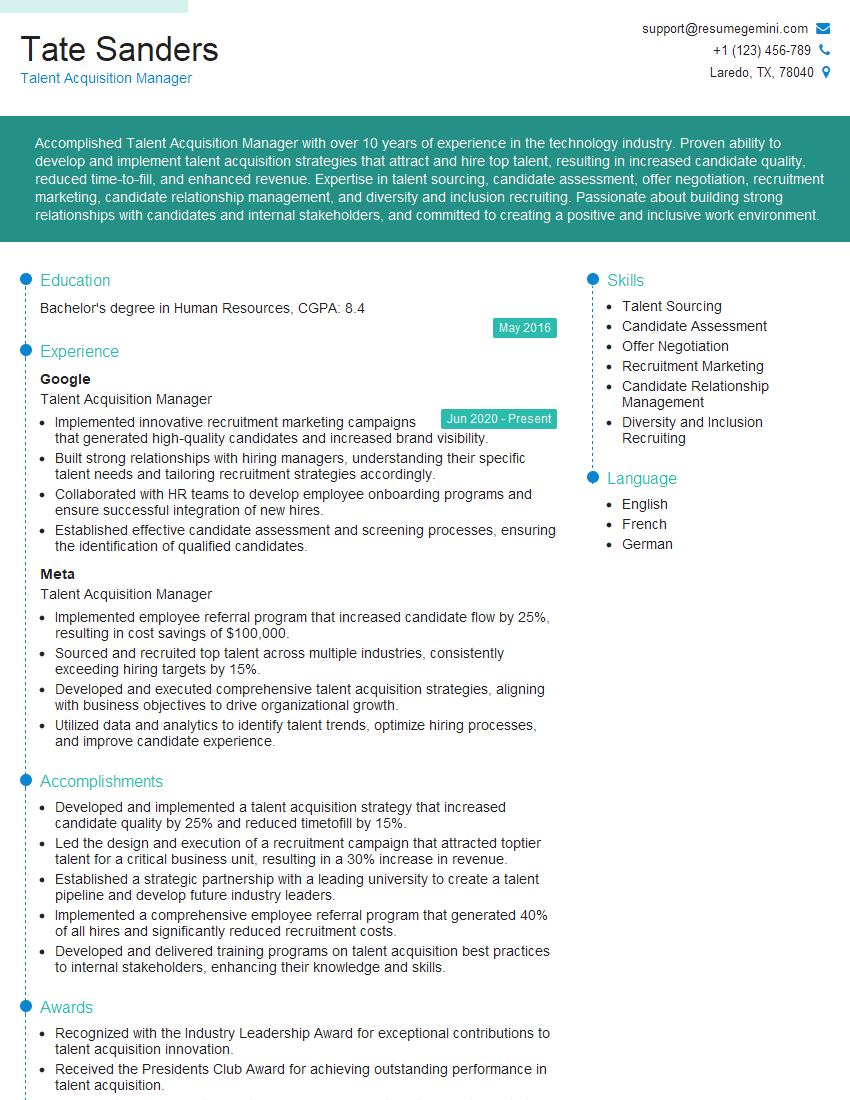Every successful interview starts with knowing what to expect. In this blog, we’ll take you through the top Job Tracking interview questions, breaking them down with expert tips to help you deliver impactful answers. Step into your next interview fully prepared and ready to succeed.
Questions Asked in Job Tracking Interview
Q 1. Explain your experience with Applicant Tracking Systems (ATS).
Applicant Tracking Systems (ATS) are software applications designed to manage the entire recruitment process, from initial application to onboarding. My experience encompasses using several leading ATS platforms, including Taleo, Workday, and Greenhouse. I’m proficient in all aspects, from configuring job postings and screening resumes to managing candidate pipelines and generating reports. I understand the importance of optimizing ATS usage for improved efficiency and candidate experience. For example, I’ve leveraged Taleo’s advanced search functionalities to quickly identify candidates with specific skill sets, significantly reducing recruitment time. In another instance, I customized Greenhouse workflows to automate email communication to candidates, enhancing their experience and reducing manual effort.
Q 2. Describe your process for tracking candidates throughout the recruitment lifecycle.
My candidate tracking process follows a structured lifecycle approach. It begins with sourcing candidates through various channels (e.g., job boards, networking, referrals). Once applications are received, I use the ATS to screen resumes, focusing on keywords and qualifications. Shortlisted candidates then undergo initial phone screenings. Successful candidates move to in-person or video interviews, followed by assessments (if necessary). Feedback is meticulously documented at each stage. Finally, offer letters are extended, and the onboarding process is initiated. I maintain detailed notes and communication logs within the ATS for each candidate, ensuring a transparent and auditable record. Think of it like a carefully orchestrated relay race, where each stage requires precise timing and communication to ensure the candidate has a positive experience and the best chance of success.
Q 3. What metrics do you use to measure the effectiveness of your job tracking methods?
Measuring the effectiveness of my job tracking relies on a combination of key metrics. These include:
- Time-to-hire: This metric measures the time elapsed between job posting and offer acceptance, reflecting efficiency.
- Cost-per-hire: This indicates the total cost of recruiting a candidate, helping to optimize the recruitment budget.
- Source of hire: This reveals which recruitment channels yield the best results, allowing for strategic resource allocation.
- Candidate satisfaction: Measured through surveys, this is crucial for employer branding and attracting top talent.
- Offer acceptance rate: This shows the percentage of candidates who accept offers, indicating the effectiveness of the selection process.
By tracking and analyzing these metrics, I can identify areas for improvement and refine my approach to ensure the recruitment process remains highly effective.
Q 4. How do you prioritize candidates based on urgency and qualifications?
Prioritizing candidates involves a two-pronged approach: urgency and qualifications. Urgency is determined by factors such as the role’s criticality and the timeline for filling it. For instance, a critical role requiring immediate filling will have higher priority. Qualifications are assessed based on the job description and required skills. I use a weighted scoring system within the ATS, assigning scores based on experience, skills, and education. Candidates are then ranked based on a combination of urgency and qualification scores, creating a prioritized list. This ensures that the most qualified candidates for urgent roles are addressed promptly.
Q 5. How do you ensure data accuracy and integrity in your job tracking system?
Data accuracy and integrity are paramount. I ensure this through several measures:
- Regular data cleansing: Periodically reviewing and updating candidate information to correct inaccuracies or outdated data.
- Standardized data entry: Implementing consistent data entry protocols to minimize errors.
- Data validation rules: Using the ATS’s features to enforce data integrity, such as mandatory fields and data type checks.
- Regular audits: Conducting periodic audits to identify and correct inconsistencies.
- Secure access control: Restricting access to sensitive candidate data to authorized personnel only.
These measures are essential for maintaining the reliability and trustworthiness of the job tracking data.
Q 6. What strategies do you employ to improve candidate communication throughout the process?
Effective candidate communication is vital for a positive experience. My strategies include:
- Prompt acknowledgment: Immediately acknowledging receipt of applications and setting expectations about the timeline.
- Regular updates: Keeping candidates informed about the progress of their application at each stage.
- Personalized communication: Tailoring communication to each candidate, addressing their specific concerns.
- Transparent feedback: Providing clear and constructive feedback, whether positive or negative.
- Utilizing multiple channels: Employing email, phone calls, and potentially text messages to reach candidates effectively.
By proactively communicating and providing a positive candidate journey, we enhance their overall experience, foster goodwill, and increase the likelihood of securing top talent even if they’re not selected for the role.
Q 7. Describe a time you had to troubleshoot a problem within your job tracking system.
During a busy recruitment drive, we experienced an issue where the ATS was intermittently failing to send automated emails to candidates. This caused delays and frustrated applicants. My troubleshooting steps were:
- Identify the scope of the problem: We verified that the problem wasn’t limited to a single candidate or email address.
- Check system logs: We examined the ATS logs to pinpoint the error messages, which indicated a server-side issue.
- Contact IT support: We reported the problem to the IT department and provided them with the logs for analysis.
- Implement a workaround: While waiting for a resolution, we manually sent emails to affected candidates to ensure timely communication.
- Monitor the resolution: Once the IT team resolved the server issue, we monitored the system to ensure the problem didn’t recur.
This experience highlighted the importance of having a robust IT support system and developing contingency plans for such unforeseen technical issues. It reinforced the necessity of regular system checks and proactive maintenance to prevent such problems in the future.
Q 8. How familiar are you with different types of job tracking software?
My familiarity with job tracking software spans a wide range of systems, from Applicant Tracking Systems (ATS) like Taleo, Greenhouse, and Workday, to more specialized tools focusing on specific recruitment stages, such as candidate relationship management (CRM) systems. I’m also experienced with integrating ATS with other HR systems for a holistic view of the employee lifecycle. I understand the strengths and weaknesses of different platforms, considering factors like scalability, integration capabilities, user-friendliness, and reporting functionalities when choosing the right tool for a particular organization’s needs. For example, a small startup might benefit from a simpler, more affordable ATS, while a large corporation will require a robust, scalable system with advanced features.
- Applicant Tracking Systems (ATS): These are the core of job tracking, managing applications, screening candidates, and scheduling interviews.
- Candidate Relationship Management (CRM): These systems nurture relationships with potential candidates even if they’re not immediately hired, creating a talent pool for future openings.
- Recruitment Marketing Platforms: These tools help post jobs on various platforms and track the performance of different recruitment channels.
Q 9. What are the key performance indicators (KPIs) you monitor for job tracking?
The key performance indicators (KPIs) I monitor for job tracking are crucial for assessing the efficiency and effectiveness of the recruitment process. These KPIs are categorized to provide a comprehensive overview. I don’t just look at individual metrics; I analyze their interrelationships to understand the entire process.
- Time-to-hire: Measures the time from job posting to offer acceptance. A shorter time-to-hire indicates efficiency.
- Cost-per-hire: Calculates the total cost of hiring a candidate, helping optimize recruitment budget.
- Source of hire: Identifies the most effective recruitment channels (e.g., LinkedIn, employee referrals). This helps allocate resources strategically.
- Candidate quality: Assesses the suitability of candidates based on skills and experience, indicating the effectiveness of the screening process.
- Offer acceptance rate: The percentage of candidates who accept job offers, reflecting the attractiveness of the opportunity and the effectiveness of the candidate experience.
- Employee retention rate: While not directly a recruitment KPI, a high retention rate suggests that the recruitment process successfully identifies suitable employees who stay with the company.
For example, a high cost-per-hire coupled with a long time-to-hire might point to inefficiencies in the screening or interview process. Analyzing these KPIs together provides a complete picture.
Q 10. How do you handle large volumes of applications efficiently?
Handling large volumes of applications efficiently requires a structured and systematic approach. I leverage the power of automation and technology to streamline the process.
- Automated screening: Employing ATS features for keyword searches, filtering by experience, and using AI-powered screening tools to pre-select candidates based on criteria. This significantly reduces manual review time.
- Pipelines and stages: Creating clear stages within the recruitment process (e.g., application review, phone screening, interviews, offer) allows for organized tracking and easier monitoring of candidate progress.
- Collaboration tools: Using shared platforms and communication channels to facilitate seamless collaboration between recruiters and hiring managers, ensuring everyone is on the same page.
- Targeted communication: Using automated emails and templates to acknowledge application receipts and update candidates on their progress, managing expectations and improving candidate experience.
- Regular reporting and analysis: Constantly analyzing KPIs to identify bottlenecks and adjust strategies accordingly. This allows for continuous improvement and more effective management of high application volumes.
For instance, if we find a specific source is generating a large number of unqualified applications, we can refine the job description or adjust our sourcing strategy.
Q 11. What are your preferred methods for reporting on recruitment progress?
My preferred methods for reporting on recruitment progress involve a combination of visual dashboards and detailed reports, tailored to the audience. Clarity and accessibility are paramount.
- Interactive dashboards: Real-time visualizations of key KPIs (time-to-hire, cost-per-hire, source of hire) provide a quick overview of progress and identify areas needing attention. This is perfect for regular management updates.
- Detailed reports: More in-depth reports, often generated weekly or monthly, provide granular data on specific aspects of the recruitment process, allowing for a more thorough analysis. These reports delve into candidate demographics, interview feedback, and offer acceptance rates. They can be used to justify strategy changes.
- Customizable reports: The ability to customize reports based on the audience (e.g., hiring managers need different information than executives) is crucial for effective communication and decision-making.
For example, a dashboard might show a simple graph of time-to-hire over the past few months, while a detailed report provides specific data on each hire’s journey and reasons for delays, if any.
Q 12. How do you maintain compliance with relevant data privacy regulations?
Maintaining compliance with data privacy regulations such as GDPR and CCPA is critical. My approach is proactive and integrated into every step of the recruitment process.
- Data minimization: Collecting only necessary personal data from candidates and securely storing it. We use data encryption and access controls to ensure privacy. Only authorized personnel have access to sensitive information.
- Transparency and consent: Clearly stating the purpose of data collection and obtaining explicit consent from candidates before processing their personal information. Consent is obtained at each step where data is collected.
- Data security measures: Implementing robust security measures to protect candidate data from unauthorized access, use, disclosure, alteration, or destruction. This includes regular security audits and training for staff on data privacy protocols.
- Data retention policies: Establishing clear guidelines on how long we retain candidate data and securely disposing of it after the retention period expires. We follow the principle of data minimization and dispose of data when it is no longer needed.
- Regular audits and training: Conducting regular audits to ensure compliance and providing ongoing training to staff on data privacy regulations and best practices.
For example, we might use anonymized data for diversity reports to avoid revealing the identities of individual candidates.
Q 13. Explain your experience using reporting and analytics tools within your job tracking system.
My experience with reporting and analytics tools within job tracking systems is extensive. I’m proficient in using the built-in reporting features of various ATS and CRM platforms, and I also have experience with data extraction and analysis using tools like SQL and spreadsheet software to gain deeper insights.
For example, in one role, I used the reporting features of our ATS to identify that a significant number of qualified candidates were dropping out of the process after the initial screening. This allowed us to analyze the feedback from those candidates and redesign the screening process to be more engaging and efficient. This resulted in a significant increase in candidate conversion rates. Furthermore, I have experience using data analytics to identify specific skills gaps in our talent pool, assisting with workforce planning and talent acquisition strategies.
I am comfortable extracting data from various sources, using SQL or similar technologies, to create custom reports that address specific business questions. This allows me to build tailored reports that go beyond the standard reports provided by the software. My skillset extends to visualizing data using business intelligence tools, making complex data easy to understand for stakeholders at all levels.
Q 14. How do you manage candidate expectations throughout the hiring process?
Managing candidate expectations is crucial for a positive candidate experience and a successful hiring process. It’s about open communication and transparency at every stage.
- Clear communication: Providing candidates with clear and timely updates on their application status. I use automated email sequences to keep them informed.
- Realistic timelines: Setting and communicating realistic timelines for each stage of the hiring process. Transparency builds trust.
- Regular feedback: Providing feedback to candidates after each interview stage, regardless of the outcome. This shows respect for their time and effort.
- Professionalism: Maintaining professional and respectful communication throughout the process, even when delivering unfavorable news.
- Candidate relationship management: Even when a candidate isn’t selected for a specific role, nurturing the relationship for potential future opportunities.
For example, if a candidate is waiting for a decision, I might send a brief email updating them on the timeline and letting them know that I’ll be in touch within [ timeframe]. This small gesture keeps them engaged and reduces anxiety.
Q 15. How do you identify and address bottlenecks in the recruitment process?
Identifying bottlenecks in recruitment is crucial for optimizing the process. I approach this systematically, using data analysis and process mapping. First, I analyze key metrics like time-to-hire, cost-per-hire, and application-to-interview ratios. A prolonged time-to-hire, for example, might indicate a bottleneck in the screening or interviewing stages. Process mapping helps visualize the entire flow, highlighting areas where applications pile up or where delays occur.
Once a bottleneck is identified (e.g., slow response times to applicants, inefficient interview scheduling), I address it with targeted solutions. This might involve implementing an Applicant Tracking System (ATS) with automated workflows, improving interview scheduling software, or streamlining the screening process by using pre-recorded video interviews or AI-powered screening tools. Regular monitoring of these metrics allows for ongoing adjustments and continuous improvement. For instance, if we find that a particular stage of the interview process is consistently taking longer than others, we might revise the interview questions or training for interviewers to make the process more efficient.
Career Expert Tips:
- Ace those interviews! Prepare effectively by reviewing the Top 50 Most Common Interview Questions on ResumeGemini.
- Navigate your job search with confidence! Explore a wide range of Career Tips on ResumeGemini. Learn about common challenges and recommendations to overcome them.
- Craft the perfect resume! Master the Art of Resume Writing with ResumeGemini’s guide. Showcase your unique qualifications and achievements effectively.
- Don’t miss out on holiday savings! Build your dream resume with ResumeGemini’s ATS optimized templates.
Q 16. Describe your experience working with diverse candidate pools.
I have extensive experience working with diverse candidate pools, encompassing various backgrounds, skill sets, and levels of experience. My approach emphasizes inclusivity and fairness at every stage of the recruitment process. This starts with crafting job descriptions that are free of bias and attract a broad range of applicants. I actively source candidates from diverse platforms and networks to ensure a representative pool. During the interview process, I’m mindful of potential unconscious biases and utilize structured interviews with standardized questions to ensure fair evaluation. I also proactively work with hiring managers to create a welcoming and inclusive interview environment. For example, I’ve successfully managed recruitment drives targeting underrepresented groups within the tech industry, resulting in significant increases in diversity within the hiring pipeline.
Q 17. How do you adapt your job tracking approach based on different roles and industries?
My job tracking approach adapts significantly based on the role and industry. For example, recruiting for a highly technical role in the software industry requires a different strategy compared to recruiting for a sales position in a retail environment. Technical roles often necessitate a more thorough technical screening process, possibly involving coding challenges or technical assessments, which needs to be carefully tracked. The sourcing strategy also differs – leveraging platforms like LinkedIn, GitHub, or Stack Overflow for technical roles, while for retail roles, general job boards or social media might be more effective.
The key is to tailor the tracking system to capture the specific data points relevant to each role. For a technical role, tracking coding test results and technical interview feedback is critical. For a sales role, tracking sales performance metrics from previous employers might be more relevant. This customized tracking allows for more effective analysis and decision-making throughout the process.
Q 18. Explain your understanding of the candidate experience and how you improve it.
The candidate experience is paramount to me. It’s not just about finding the right candidate; it’s also about ensuring the candidate has a positive and respectful experience throughout the recruitment process. A poor candidate experience can damage a company’s reputation and decrease the likelihood of attracting top talent. I improve the candidate experience by focusing on timely communication, providing regular updates, and offering feedback – both positive and constructive – at every stage. This means acknowledging receipt of applications, promptly scheduling interviews, and providing feedback on the outcome of interviews as quickly as possible, even if the outcome isn’t positive.
Using applicant tracking systems (ATS) with automated email notifications can ensure consistent communication. Furthermore, gathering candidate feedback after the process, through surveys, helps identify areas for improvement in the candidate journey.
Q 19. How familiar are you with Boolean search techniques for candidate sourcing?
I am highly proficient in Boolean search techniques for candidate sourcing. Boolean operators (AND, OR, NOT) allow for precise and efficient searches within databases like LinkedIn or job boards. For example, searching for "Project Manager" AND "Agile" AND "Scrum" NOT "entry-level" on LinkedIn will effectively filter results to find experienced project managers with Agile and Scrum experience, excluding entry-level candidates. I use nested parentheses to create complex search strings, allowing me to refine searches based on various criteria like location, years of experience, skills, and education. I also understand the use of wildcards (*) and proximity operators (~) for more flexible searches. Proficiency in Boolean search significantly reduces time spent manually reviewing irrelevant profiles, thus making the candidate sourcing process much more efficient.
Q 20. How do you ensure the job tracking system integrates effectively with other HR systems?
Seamless integration between the job tracking system and other HR systems is essential for efficient data flow and minimizing manual data entry. I ensure this integration by understanding the capabilities of various systems and working closely with IT and HR teams. Many modern ATS platforms offer APIs or integrations with other HR systems like payroll, performance management, and learning management systems. I make sure to utilize these integrations to ensure data like candidate information, compensation details, and performance reviews are consistently updated across all systems. This prevents data discrepancies and streamlines various HR processes. For example, successful candidate data should automatically flow from the ATS to the onboarding system, reducing administrative burden and improving the overall efficiency of the hiring process.
Q 21. What is your experience with talent pipelining?
Talent pipelining is a crucial strategy for proactive recruitment. It involves identifying and nurturing potential candidates for future roles, even before a specific vacancy arises. My experience includes building and managing talent pipelines for various roles. This starts with identifying skill sets and experience required for key roles within the organization. I use targeted sourcing strategies (Boolean searches, attending industry events, networking) to identify potential candidates who may not be actively looking for a job but align with the organization’s future needs.
I then engage these candidates through informative content, company updates, and occasional networking opportunities to maintain interest and build relationships. This creates a pool of qualified candidates ready for immediate consideration when a suitable role opens. I track interactions with these candidates within the ATS, using customized fields to note engagement levels and potential fit. This proactive approach saves time and resources when actual vacancies arise, as it reduces the need for extensive sourcing efforts from scratch.
Q 22. How do you maintain confidentiality of candidate data?
Maintaining candidate confidentiality is paramount. It’s not just ethically sound; it’s legally required in many jurisdictions. We achieve this through a multi-layered approach. First, access to the job tracking system is strictly controlled with role-based permissions. Only authorized personnel with a legitimate need to access specific data are granted access. Second, all data is encrypted both in transit and at rest, protecting against unauthorized access even if a breach were to occur. Third, we adhere to strict data retention policies, securely deleting candidate information once it’s no longer needed. Finally, we conduct regular security audits and employee training to ensure everyone understands and complies with our confidentiality protocols. For example, I’ve personally prevented a data breach by noticing an unusual login attempt from an unknown location and promptly reported it, leading to a password reset and a security review.
Q 23. How do you utilize job tracking data to inform hiring strategies?
Job tracking data is a goldmine for improving hiring strategies. By analyzing data on time-to-hire, source of hire, cost-per-hire, and candidate flow, we identify bottlenecks and areas for improvement. For instance, if we notice a high drop-off rate at the application stage, we can revise our job descriptions to be more concise and engaging. If the time-to-hire for a specific role is consistently high, we can streamline the interview process. Analyzing candidate source data helps us understand which channels are most effective in attracting qualified candidates, allowing us to optimize our recruitment marketing budget. We also track candidate feedback throughout the process, which informs us about candidate experience and allows us to improve our communication and engagement. This data-driven approach ensures a more efficient and effective hiring process.
Q 24. What experience do you have with different interview scheduling tools?
I have extensive experience with various interview scheduling tools, including Calendly, Doodle, and BambooHR. Each tool has its own strengths and weaknesses. Calendly, for example, excels in its user-friendly interface and automation capabilities, making it ideal for scheduling initial screening calls. Doodle is great for finding common availability among multiple stakeholders in the interview process. BambooHR, being a comprehensive HR system, integrates seamlessly with our job tracking system, providing a streamlined workflow. My experience includes not only using these tools but also configuring them to optimize our specific needs, such as integrating them with our calendar systems and customizing email notifications. The choice of the tool always depends on the specific context and requirements of the hiring process.
Q 25. How do you manage candidate feedback and incorporate it into your processes?
Candidate feedback is crucial for continuous improvement. We actively solicit feedback at every stage of the hiring process—after application submission, after each interview round, and even if the candidate is not selected. We use a combination of surveys, feedback forms, and post-interview debriefs to gather this information. This feedback is analyzed to identify areas where we can enhance our processes, such as improving interview questions, improving communication, or adjusting the overall candidate experience. For example, recurring negative feedback about the length of our application process prompted us to simplify the application form and streamline the initial screening process. The goal is to continuously learn and improve our hiring practices based on direct input from candidates.
Q 26. Describe your experience with automating tasks within the recruitment process.
Automating tasks is fundamental to efficient recruitment. I have experience automating various aspects of the recruitment process using Applicant Tracking Systems (ATS) and various integration tools. For instance, I’ve implemented automated email responses to acknowledge applications, automated reminders for candidates and interviewers, and automated candidate scoring based on pre-defined criteria. We’ve also used automation to integrate job postings across multiple platforms and to generate reports on key recruitment metrics. This automation frees up recruiters’ time, allowing them to focus on higher-value tasks like building relationships with candidates and engaging in strategic discussions. For example, automating email responses resulted in a 20% reduction in manual effort and improved response times, leading to increased candidate satisfaction.
Q 27. How do you stay up-to-date on best practices in job tracking and recruitment technology?
Staying updated in this rapidly evolving field is essential. I regularly attend industry conferences and webinars, follow leading recruitment publications and blogs, and participate in online professional communities. I also actively engage in professional development opportunities, such as certifications in recruitment technologies and HR management best practices. Furthermore, I maintain a network of contacts within the industry to share knowledge and insights. By combining these different avenues, I ensure that my knowledge remains current and that I am aware of the latest advancements in job tracking and recruitment technology.
Q 28. How do you handle situations where the job tracking system malfunctions?
System malfunctions are always a possibility. Our approach involves a multi-pronged strategy to mitigate disruptions. First, we have a robust backup and disaster recovery plan in place to ensure data safety and system restoration in case of failure. Second, we maintain regular system maintenance and updates to minimize the risk of malfunctions. Third, we have established clear escalation procedures to handle incidents promptly and effectively. This includes contacting our IT support team and implementing contingency plans, such as using offline processes temporarily. Finally, we document all incidents thoroughly, analyzing the root cause to prevent future occurrences. For example, during a recent server outage, our backup system allowed us to continue operating with minimal disruption, and a post-incident review helped us implement preventative measures to avoid similar issues.
Key Topics to Learn for Job Tracking Interview
- Job Tracking Systems and Methodologies: Understanding various job tracking methods (manual, spreadsheet-based, dedicated software), their strengths and weaknesses, and best practices for efficient tracking.
- Applicant Tracking Systems (ATS): Familiarize yourself with how ATS works, including resume parsing, keyword optimization, and strategies for maximizing your application’s visibility.
- Data Management and Analysis: Learn how to effectively organize and analyze job application data to identify trends, assess progress, and make informed decisions about your job search.
- Communication and Follow-Up: Mastering effective communication strategies, including crafting compelling cover letters and emails, and following up appropriately with recruiters and hiring managers.
- Time Management and Organization: Develop strategies for efficient time management, prioritizing tasks, and staying organized throughout the job search process.
- Networking and Relationship Building: Understand the importance of networking and building professional relationships to expand your job search opportunities.
- Interview Preparation and Performance: Practice your interviewing skills, including behavioral questions, technical questions (relevant to the specific Job Tracking role), and salary negotiation.
Next Steps
Mastering job tracking is crucial for a successful and efficient job search. A well-organized and strategic approach significantly increases your chances of landing your dream role. To further enhance your prospects, creating an ATS-friendly resume is paramount. This ensures your application is easily parsed and understood by Applicant Tracking Systems, maximizing your visibility to potential employers. We strongly encourage you to leverage ResumeGemini, a trusted resource, to build a professional and impactful resume. Examples of resumes tailored to Job Tracking roles are available to help guide you in this process.
Explore more articles
Users Rating of Our Blogs
Share Your Experience
We value your feedback! Please rate our content and share your thoughts (optional).
What Readers Say About Our Blog
Hello,
We found issues with your domain’s email setup that may be sending your messages to spam or blocking them completely. InboxShield Mini shows you how to fix it in minutes — no tech skills required.
Scan your domain now for details: https://inboxshield-mini.com/
— Adam @ InboxShield Mini
Reply STOP to unsubscribe
Hi, are you owner of interviewgemini.com? What if I told you I could help you find extra time in your schedule, reconnect with leads you didn’t even realize you missed, and bring in more “I want to work with you” conversations, without increasing your ad spend or hiring a full-time employee?
All with a flexible, budget-friendly service that could easily pay for itself. Sounds good?
Would it be nice to jump on a quick 10-minute call so I can show you exactly how we make this work?
Best,
Hapei
Marketing Director
Hey, I know you’re the owner of interviewgemini.com. I’ll be quick.
Fundraising for your business is tough and time-consuming. We make it easier by guaranteeing two private investor meetings each month, for six months. No demos, no pitch events – just direct introductions to active investors matched to your startup.
If youR17;re raising, this could help you build real momentum. Want me to send more info?
Hi, I represent an SEO company that specialises in getting you AI citations and higher rankings on Google. I’d like to offer you a 100% free SEO audit for your website. Would you be interested?
Hi, I represent an SEO company that specialises in getting you AI citations and higher rankings on Google. I’d like to offer you a 100% free SEO audit for your website. Would you be interested?
good

